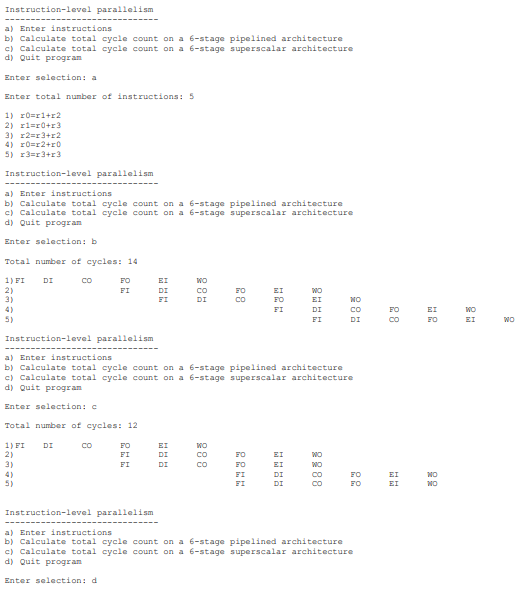Question
OBJECTIVE: In C, calculate the performance of a program with dependent arithmetic instructions, by simulating the execution on (i) a simple 6-stage pipeline architecture; (ii)
OBJECTIVE:
In C, calculate the performance of a program with dependent arithmetic instructions, by simulating the execution on (i) a simple 6-stage pipeline architecture; (ii) a superscalar 6- stage architecture of degree 2 (2 sets of functional units). The six stages are: Fetch Instruction (FI), Decode Instruction (DI), Calculate Operands (CO), Fetch Operands (FO), Execute Instructions (EI), and Write Output (WO).
INPUTS:
- Number of instructions in the program
- Set of automatically numbered instructions containing arithmetic register assignments
- Architecture to simulate program on (pipelined, superscalar)
OUTPUTS:
- The total cycle count for the program
- A Gantt chart of the pipelined stages of the instructions
SPECIFICATIONS:
The program calculates the performance of a set of arithmetic register assignment statements and prints out the aligned pipelined instructions based on choosing from a menu of choices, where each choice calls the appropriate procedure:
a) Enter instructions
b) Calculate total cycle count on a 6-stage pipelined architecture
c) Calculate total cycle count on a 6-stage superscalar architecture
d) Quit program
-------------------------------------------------------------------------------------------
SAMPLE OUTPUT (SHOW YOURS WORKS LIKE THIS)
-------------------------------------------------------------------------------------------

-------------------------------------------------------------------------------------------
SKELETON CODE
-------------------------------------------------------------------------------------------
#include #include
/* Define structure for instruction containing fields for destination register, 2 source registers, and individual instruction delay and a variable as pointer to structure for creating a dynamic array of instructions */
/*************************************************************/ void FUNCTION TO PRINT OUT CHART OF INSTRUCTIONS WITH DELAYS() { /* Declare local variables */ /* For each instruction, align instructions by tabbing according to delay, and print out stages with proper tabbing (FI\tDI\tCO\tFO\tEI\tWO) */ return; }
/*************************************************************/ void FUNCTION TO ENTER INSTRUCTIONS() { /* Declare local variables, including an array of characters to store user input */
/* Prompt for total number of instructions */ /* Allocate memory to hold a set of instructions based on total number of instructions+1 (instruction 0 used for dependency checking)*/
/* Initialize instruction 0's destination register to -1 to prevent false RAW dependency w/ instruction 2 */
/* For each instruction, prompt for user input with instruction number, such as: 1) and read instruction as a string and store at proper field of appropriate index within dynamic array of instructions */
return; }
/*****************************************************/ void FUNCTION TO CALCULATE DELAY OF SET OF INSTRUCTIONS ON A 6-STAGE PIPLELINE ARCHITECTURE { /* Declare local variables */
/* For each instruction i from 2 to total number of instructions, initialize delay as 0 and check for dependency between instruction (i-2) and i, as well as between instruction (i-1) and i */
{ /* begin for-loop */
/* If dependency, set delay appropriately, as well as a flag to check for possible overlap between dependent instructions */
/* Note: general formula for delay: delay=2 if instruction i depends on instruction (i-1) delay=1 if instruction i depends on instruction (i-2) and no overlap of dependencies delay=0 otherwise */
/* Calculate individual delay for current instruction */
} /* end for-loop */
/* print chart */ return; }
/***************************************************************/
void FUNCTION TO CALCULATE DELAY OF SET OF INSTRUCTIONS ON A 6-STAGE SUPERSCALAR ARCHITECTURE { /* Declare local variables */
/* For each instruction i from 2 to total number of instructions */
{ /* begin for-loop */
/* Flip the flag used for expectedon-expected pipeline delay to resemble delay pattern for superscalar: if flag is 0, set it to 1, if it is 1, reset it to 0 */
initialize delay as 0 and check for dependencies between instruction (i-4) and i, (i-3) and i, all the way to (i-1) and i */
/* If dependency, set delay appropriately, as well as setting flag for expected pipeline delay to 1, and set flag to check for possible overlap between dependent instructions */
/* Note: general formula for delay: delay=2 if instruction i depends on instruction (i-1)
delay=2 if instruction i depends on instruction (i-2) and expected pipeline delay and no overlap of dependencies
delay=1 if instruction i depends on instruction (i-2) and no expected pipeline delay and no overlap of dependencies
delay=1 if instruction i depends on instruction (i-3) and no overlap of dependencies
delay=1 if instruction i depends on instruction (i-4) and expected pipeline delay and no overlap of dependencies
delay=0 otherwise */
/* Calculate individual delay for current instruction */
} /* end for-loop */
/* print chart */
return; }
/****************************************************************/ int main() { /* Declare local variables */
/* Until user quits, print menu, prompt for user input, and select corresponding function */
return 1; }
Instruction-level parallelism a) Enter instructions b) Calculate total cycle count on a 6-stage pipelined architecture c) Calculate total cycle count on a 6-stage superscalar architecture d) Quit progran Enter selection: a Enter total nunber of instructions: 5 1) 2) 3) r0 r1+r2 r1=r0+r3 r2=r1+r2 5) r3=r2+r3 Instruction-level parallelism a) Enter instructions b) Calculate total cycle count on a 6-stage pipelined architecture c) Calculate total cycle count on a 6-stage superscalar architecture d) Quit progran Enter selection: b Total number of cycles: 14 1)F D 21 EI DI EI Instruction-level parallelism a) Enter instructions b) Calculate total cycle count on a 6-stage pipelined architecture c) Calculate total cycle count on a 6-stage superscalar architecture d) Quit progran Enter selection: c Total number of cycles: 12 1)FI DI EI EI Instruction-level parallelism a) Enter instructions b) Calculate total cycle count on a 6-stage pipelined architecture c) Calculate total cycle count on a 6-stage superscalar architecture d) Quit progran Enter selection: dStep by Step Solution
There are 3 Steps involved in it
Step: 1

Get Instant Access to Expert-Tailored Solutions
See step-by-step solutions with expert insights and AI powered tools for academic success
Step: 2

Step: 3

Ace Your Homework with AI
Get the answers you need in no time with our AI-driven, step-by-step assistance
Get Started


